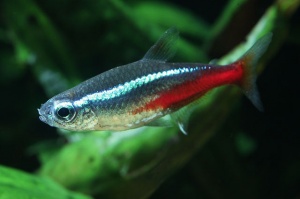Natural color of gem-gum products
An interesting question is about how products out of gemstone based metamaterials will look like when no additional efforts are taken in order to change the visual appearance of the material.
Contents
- 1 transparent inherited look from the gemstone base material
- 2 iridescent CD/DVD like look from ordered sub-micron structures
- 3 pitch black obsidian like look from accidental color-centers that over-dope
- 4 albino animal like look in case of bigger and/ore more irregular internal micro-structures
- 5 specular reflective look on surfaces and rounded edges
- 6 (golden) mirror look in case of UV vulnerable internal structures
- 7 External Links
transparent inherited look from the gemstone base material

If all of the internal structure
- is below the wavelength of visible light and
- is highly regular
then the material will most likely be completely transparent.
Moissanite based materials will likely inherit its high color dispersion (splitting wight light particularly strongly up into its rainbow of colors).
Moissanite (SiC) or rutile (TiO2) based materials will likely inherit the very high refractive index (near 3.0 rather than near 1.5 for quartz or its very hard stishovite polymorph). Ordered internal structures may cause prominent birefringence and influence the polarization of light.
Complex irregular internal nano-structures do not necessarily contradict transparent appearance even on larger scales like many centimeters. This can be seen in many deep sea fish, jellifish and e.g. the very popular neon tetra fish. Water and tissue materials having a similar refractive index plays a role too but is nit the main factor here.
As a reminder: The analogies between soft biological nanosystems and much stiffer gemstone based metamaterial nanosystems do hold up only to a very limited degree. Beyond that they can cause confusion and misinterpretation (see biological analogies).
iridescent CD/DVD like look from ordered sub-micron structures
In case of regular structures near the wavelenth of light iridescent looks like on CDs and DVDs may occur.
pitch black obsidian like look from accidental color-centers that over-dope
If there are (due to structural or other but not optical reasons) metal atom color-centres in the parts (like what gives natural gemstones their color -- see color emulation), then the parts may be colored. But since doping has a strong effect even with beginning even with very low concentrations it's likely that the accidentally resulting color is so dark that the material appears black (similar to obsidian).
albino animal like look in case of bigger and/ore more irregular internal micro-structures
If there are larger micro-structures within the material at (and slightly above) the wavelength of visible light, and these micro-structures are irregular and at least pseudo-statistical in nature, then there will be scattering of light. This may lead to a look of the products akin to what one can observe with animals that feature albinism. There is white subsurface subsurface of various intensity. This may range from barely recognizable (the part is still mostly transparent) over slightly smokey like Areogel looks like over decently strong (only sharp edged are kind of ghostly see-through) to a solid white bright paper like appearance.
specular reflective look on surfaces and rounded edges
Given atomically precise perfectly flat surfaces there will be quite a bit of secular reflection. So one may see the environment reflected on the parts surfaces. Just as with a shiny computer screen, but with the difference that the color below is white. Thus the reflection will be more hard to make out. Given all sharp corners being rounded to radii of about halve a millimetre or so for save handling of the parts without cutting oneself in the fingers, small disk light sources (like the sun) will cause short bright line reflections on these edges.
(golden) mirror look in case of UV vulnerable internal structures
If there are structures inside products that would be vulnerable to natural UV light then these products will (if properly designed) have near the surface a layer that is sufficiently electrically conductive in the high frequency range of the impinging UV light that it behaves metallic (related: plasma frequency, evanescent wave) and reflacts back that dangerous potentially chemical bond braking UV light before it can penetrate to the inside of the product where the UV vulnearble nanostructures reside. While this pseudo-metallic layer not necessarily may be made from metals (conductive carbon nanotubes may work too) this layer may very well make the parts look metallic. Actually it would suffice to filter out just the aggressive UV light, but the filtering may stetch haveway over the visible range giving the products a gold reflectivity (like the gold plated mylar foils - thin PET foils - seen on many spacecraft) to dark reddish reflectivity. Or when stretching fully over the visible spectrum then it will simply become like a mirror. If the UV protective layer is not at the topmost surface (likely) then its even more like a mirror that has been metallized from behind.


